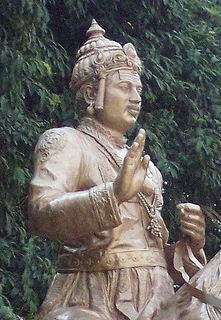 W
WIndian religions, sometimes also termed Dharmic religions or Indic religions, are the religions that originated in the Indian subcontinent; namely Hinduism, Jainism, Buddhism, and Sikhism. These religions are also all classified as Eastern religions. Although Indian religions are connected through the history of India, they constitute a wide range of religious communities, and are not confined to the Indian subcontinent.
 W
WThe Ahom religion is the ethnic religion of the Ahom people. The Ahom people came into Assam in 1228, led by a Tai prince Sukaphaa, and admixed with the local people. The people who came into Assam included two clans of priests, joined later by a third, who brought with them their own religion, rituals, practices and scriptures. The religion is based on ritual-oriented ancestor worship that required animal sacrifice (Ban-Phi), though there are numerous Hinduism and Buddhism influenced ritual in which sacrifice was forbidden (Phuralung). Ancestor worship and the animistic concept of khwan are two elements it shares with other Tai folk religions. As the southeast Asia region was heavily Hindu and later Buddhist by the first century AD, the traditional religion has heavy influences from the two religions as evidenced in the titular god of the Ahom king and though there is a concept of heaven or a heavenly kingdom, there is no concept of hell. It was the state religion of the Ahom kingdom in the initial period.
 W
WAjivika is one of the nāstika or "heterodox" schools of Indian philosophy. Purportedly founded in the 5th century BCE by Makkhali Gosala, it was a śramaṇa movement and a major rival of Vedic religion, early Buddhism and Jainism. Ājīvikas were organised renunciates who formed discrete communities. The precise identity of the Ajivikas is not well known, and it is even unclear if they were a divergent sect of the Buddhists or the Jains.
 W
WHaidakhan Babaji, simply called Babaji by his students and devotees, was a religious teacher who appeared near the village of Haidakhan in northern India (Uttarakhand) and taught publicly from 1970 until his death in 1984. He has a following in the Western world, and two ashrams in India.
 W
WBathouism (बाथौ) is the ethnic religion of the Bodo people or Kachari people. The name Bathou in Bodo means five principles. The five principles are: bar (air), orr (fire), ha (earth), dwi (water) and okhrang (ether). The chief deity, called Bathoubwrai —omnipresent, omniscient and omnipotent—is said to have created the five principles. Though there are other minor gods and goddesses, Bathoubwrai is considered the Supreme God. Bathoubwrai is unseen. The second most important deity is Mainao, the consort of Bathoubwrai, who is considered as the "protector of the rice fields".
 W
WDinkoism, the Dinkoist religion, or Dinkamatham is an Indian parody religion and a social movement that emerged and evolved on social networks organized by independent welfare groups in the Indian state of Kerala. Adherents describe Dinkoism as a genuine religion.
 W
WDonyi-Polo is the designation given to the indigenous religion, of animistic and shamanic type, of the Tani and other Tibeto-Burman peoples of Arunachal Pradesh and Assam in Northeast India. The name "Donyi-Polo" means "Sun-Moon", and was chosen for the religion in the process of its revitalisation and institutionalisation started in the 1970s in response to inroads made by Christianity and the possibility of absorption into Hinduism.
 W
WThe early Dravidian religion constituted a pre-Vedic form of Hinduism in that they were either historical or are at present Āgamic. The Agamas are non-Vedic in origin, and have been dated either as post-Vedic texts, or as pre-Vedic compositions. The Agamas are a collection of Tamil and Sanskrit scriptures chiefly constituting the methods of temple construction and creation of murti, worship means of deities, philosophical doctrines, meditative practices, attainment of sixfold desires and four kinds of yoga. The worship of tutelary deity, sacred flora and fauna in Hinduism is also recognized as a survival of the pre-Vedic Dravidian religion. Dravidian linguistic influence on early Vedic religion is evident, many of these features are already present in the oldest known Indo-Aryan language, the language of the Rigveda, which also includes over a dozen words borrowed from Dravidian. The linguistic evidence for Dravidian impact grows increasingly strong as we move from the Samhitas down through the later Vedic works and into the classical post-Vedic literature. This represents an early religious and cultural fusion or synthesis between ancient Dravidians and Indo-Aryans that went on to influence Indian civilization.
 W
WKirat Mundum, also known as Kirati Mundum or Kiratism, is the indigenous religion of the Kirati ethnic groups of Nepal, Darjeeling and Sikkim: Limbu, Rai, Sunuwar and Yakkha peoples. The practice is also known as Kirat Veda, Kirat-Ko Veda or Kirat Ko Ved. According to some scholars, such as Tom Woodhatch, it is shamanism, animistic religion or blend of shamanism, animism, and Shaivism. It is practiced by about 3.1% of the Nepali population. Its Limbu language slogan is,.
 W
WLingayatism is a Shaivite Hindu religious tradition in India. Initially known as Veerashaivas, since the 12th century adherents of this faith are known as Lingayats. The terms Lingayatism and Veerashaivism have been used synonymously, but Veerashaivism may refer to the broader Veerashaiva philosophy which predates Lingayatism, to the historical community now called Lingayats, and to a contemporary (sub)tradition within Lingayatism with Vedic influences.
 W
WReligion in the Punjab in ancient history was characterized by Hinduism and later conversions to Jainism, Buddhism, Islam, Sikhism and Christianity; it also includes folk practices common to all Punjabis regardless of the religion they adhere to. Such practices incorporate local mysticism and include ancestral worship, worship of local saints.
 W
WSanamahism, also known as Meitei religion, Manipuri religion or Kanglei religion, is an animistic, ancestor-worshipping, shaman-led religious tradition found among the Meitei people in Manipur state of India. The term is derived from Sanamahi, the most important Meitei deity. The details of the identity of Lainingthou Sanamahi – sun, fire, or an aspect of Sidaba Mapu – along with other aspects of the Sanamahism beliefs, practices and the history, are unclear and disputed. Broadly, Sanamahism worship elements of nature, such as fire, water and mountains, with a notable temple and worship rituals at the Loi village of Andro, east of Imphal, according to Bertil Lintner. After the forced conversion of Meiteis to Hinduism by the then king in the 18th century, Sanamahism is practised alongside Hinduism in most Meitei homes in Imphal, the capital of Kangleipak. However, many Meiteis outside Imphal did not convert, and practice only Sanamahism. In every Meitei home, including those who are also Hindus, there are two sacred spaces where Sanamahi deities are worshipped, viz., a corner in the north-west called Sanamahi Kachin dedicated to Lainingthou and Leimarel Sidabi and next to the fireplace or hearth (Phung-ga) in the kitchen for Goddess Emoinu, the goddess of well being and prosperity. This is seen in modern Meitei families who identify with Sanamahism. According to Kanglei mythology life began from water in the form of "Namu Mitam Nga" commonly known as the "Ngamu" fish.
 W
WSarna are sacred groves in the religious traditions of the Chota Nagpur Plateau region in the states of Jharkhand, Bihar, Assam and Chhattisgarh. Followers of these rituals primarily belong to the Baiga, Ho, Kurukh, Munda, Kudmi and Santal. According to local belief, a Gram deoti or village deity resides in the sarna, where sacrifice is offered twice a year.
 W
WSikhism or Sikhi is an Indian Dharmic religion that originated in the Punjab region of the Indian subcontinent around the end of the 15th century CE. Sikhism is one of the youngest of the major religions and the world's fifth-largest organized religion, with about 25-30 million Sikhs as of the early-21st century. However, according to rough estimates, there are around 120–150 million Sahajdhari or non-khalsa Nanakpanthi sikhs across the world who also believe in 10 Sikh Gurus and Guru Granth Sahib.
 W
WSri Satru Samhara Moorthy is a Hindu religious figure and god.
Zoroastrianism or Mazdayasna is one of the world's oldest continuously practiced religions, based on the teachings of the Iranian-speaking prophet Zoroaster. Zoroastrianism has a dualistic cosmology of good and evil and an eschatology which predicts the ultimate conquest of evil by good. Zoroastrianism exalts an uncreated and benevolent deity of wisdom, Ahura Mazda, as its supreme being. The unique historical features of Zoroastrianism, such as its monotheism, messianism, judgment after death, heaven and hell, and free will may have influenced other religious and philosophical systems, including Second Temple Judaism, Gnosticism, Greek philosophy, Christianity, Islam, the Baháʼí Faith, and Buddhism.